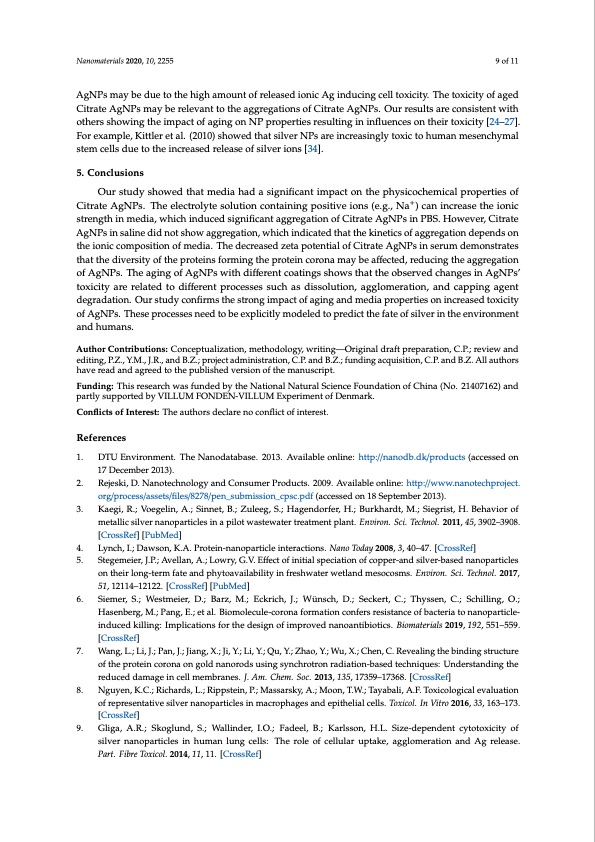
PDF Publication Title:
Text from PDF Page: 009
Nanomaterials 2020, 10, 2255 9 of 11 AgNPs may be due to the high amount of released ionic Ag inducing cell toxicity. The toxicity of aged Citrate AgNPs may be relevant to the aggregations of Citrate AgNPs. Our results are consistent with others showing the impact of aging on NP properties resulting in influences on their toxicity [24–27]. For example, Kittler et al. (2010) showed that silver NPs are increasingly toxic to human mesenchymal stem cells due to the increased release of silver ions [34]. 5. Conclusions Our study showed that media had a significant impact on the physicochemical properties of Citrate AgNPs. The electrolyte solution containing positive ions (e.g., Na+) can increase the ionic strength in media, which induced significant aggregation of Citrate AgNPs in PBS. However, Citrate AgNPs in saline did not show aggregation, which indicated that the kinetics of aggregation depends on the ionic composition of media. The decreased zeta potential of Citrate AgNPs in serum demonstrates that the diversity of the proteins forming the protein corona may be affected, reducing the aggregation of AgNPs. The aging of AgNPs with different coatings shows that the observed changes in AgNPs’ toxicity are related to different processes such as dissolution, agglomeration, and capping agent degradation. Our study confirms the strong impact of aging and media properties on increased toxicity of AgNPs. These processes need to be explicitly modeled to predict the fate of silver in the environment and humans. Author Contributions: Conceptualization, methodology, writing—Original draft preparation, C.P.; review and editing, P.Z., Y.M., J.R., and B.Z.; project administration, C.P. and B.Z.; funding acquisition, C.P. and B.Z. All authors have read and agreed to the published version of the manuscript. Funding: This research was funded by the National Natural Science Foundation of China (No. 21407162) and partly supported by VILLUM FONDEN-VILLUM Experiment of Denmark. Conflicts of Interest: The authors declare no conflict of interest. References 1. DTU Environment. The Nanodatabase. 2013. Available online: http://nanodb.dk/products (accessed on 17 December 2013). 2. Rejeski, D. Nanotechnology and Consumer Products. 2009. Available online: http://www.nanotechproject. org/process/assets/files/8278/pen_submission_cpsc.pdf (accessed on 18 September 2013). 3. Kaegi, R.; Voegelin, A.; Sinnet, B.; Zuleeg, S.; Hagendorfer, H.; Burkhardt, M.; Siegrist, H. Behavior of metallic silver nanoparticles in a pilot wastewater treatment plant. Environ. Sci. Technol. 2011, 45, 3902–3908. [CrossRef] [PubMed] 4. Lynch, I.; Dawson, K.A. Protein-nanoparticle interactions. Nano Today 2008, 3, 40–47. [CrossRef] 5. Stegemeier, J.P.; Avellan, A.; Lowry, G.V. Effect of initial speciation of copper-and silver-based nanoparticles on their long-term fate and phytoavailability in freshwater wetland mesocosms. Environ. Sci. Technol. 2017, 51, 12114–12122. [CrossRef] [PubMed] 6. Siemer, S.; Westmeier, D.; Barz, M.; Eckrich, J.; Wünsch, D.; Seckert, C.; Thyssen, C.; Schilling, O.; Hasenberg, M.; Pang, E.; et al. Biomolecule-corona formation confers resistance of bacteria to nanoparticle- induced killing: Implications for the design of improved nanoantibiotics. Biomaterials 2019, 192, 551–559. [CrossRef] 7. Wang, L.; Li, J.; Pan, J.; Jiang, X.; Ji, Y.; Li, Y.; Qu, Y.; Zhao, Y.; Wu, X.; Chen, C. Revealing the binding structure of the protein corona on gold nanorods using synchrotron radiation-based techniques: Understanding the reduced damage in cell membranes. J. Am. Chem. Soc. 2013, 135, 17359–17368. [CrossRef] 8. Nguyen, K.C.; Richards, L.; Rippstein, P.; Massarsky, A.; Moon, T.W.; Tayabali, A.F. Toxicological evaluation of representative silver nanoparticles in macrophages and epithelial cells. Toxicol. In Vitro 2016, 33, 163–173. [CrossRef] 9. Gliga, A.R.; Skoglund, S.; Wallinder, I.O.; Fadeel, B.; Karlsson, H.L. Size-dependent cytotoxicity of silver nanoparticles in human lung cells: The role of cellular uptake, agglomeration and Ag release. Part. Fibre Toxicol. 2014, 11, 11. [CrossRef]PDF Image | Silver Nanoparticles Undergoing Long-Term Aging

PDF Search Title:
Silver Nanoparticles Undergoing Long-Term AgingOriginal File Name Searched:
nanomaterials-10-02255-v3.pdfDIY PDF Search: Google It | Yahoo | Bing
Turbine and System Plans CAD CAM: Special for this month, any plans are $10,000 for complete Cad/Cam blueprints. License is for one build. Try before you buy a production license. More Info
Waste Heat Power Technology: Organic Rankine Cycle uses waste heat to make electricity, shaft horsepower and cooling. More Info
All Turbine and System Products: Infinity Turbine ORD systems, turbine generator sets, build plans and more to use your waste heat from 30C to 100C. More Info
CO2 Phase Change Demonstrator: CO2 goes supercritical at 30 C. This is a experimental platform which you can use to demonstrate phase change with low heat. Includes integration area for small CO2 turbine, static generator, and more. This can also be used for a GTL Gas to Liquids experimental platform. More Info
Introducing the Infinity Turbine Products Infinity Turbine develops and builds systems for making power from waste heat. It also is working on innovative strategies for storing, making, and deploying energy. More Info
Need Strategy? Use our Consulting and analyst services Infinity Turbine LLC is pleased to announce its consulting and analyst services. We have worked in the renewable energy industry as a researcher, developing sales and markets, along with may inventions and innovations. More Info
Made in USA with Global Energy Millennial Web Engine These pages were made with the Global Energy Web PDF Engine using Filemaker (Claris) software.
Infinity Turbine Developing Spinning Disc Reactor SDR or Spinning Disc Reactors reduce processing time for liquid production of Silver Nanoparticles.
| CONTACT TEL: 608-238-6001 Email: greg@infinityturbine.com | RSS | AMP |